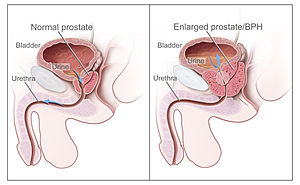Benign prostatic hyperplasia
| Benign prostatic hyperplasia | |
|---|---|
| Synonyms | adenofibromyomatous hyperplasia, benign prostatic hypertrophy |
 |
|
| Diagram illustrating normal prostate (left) and benign prostatic hyperplasia (right). | |
| Classification and external resources | |
| Specialty | Urology |
| ICD-10 | N40 |
| ICD-9-CM | 600 |
| OMIM | 600082 |
| DiseasesDB | 10797 |
| MedlinePlus | 000381 |
| eMedicine | med/1919 |
| Patient UK | Benign prostatic hyperplasia |
| MeSH | D011470 |
Benign prostatic hyperplasia (BPH), also called benign enlargement of the prostate (BEP or BPE), is a noncancerous increase in size of the prostate. BPH involves hyperplasia of prostatic stromal and epithelial cells, resulting in the formation of large, fairly discrete nodules in the transition zone of the prostate. BPH involves hyperplasia (an increase in the number of cells) rather than hypertrophy (a growth in the size of individual cells), but the two terms are often used interchangeably, even among urologists.
When sufficiently large, the nodules push on and narrow the urethra resulting in an increased resistance to flow of urine from the bladder. This is commonly referred to as "obstruction", although the urethral lumen is no less patent, only compressed. Resistance to urine flow requires the bladder to work harder during voiding, possibly leading to progressive hypertrophy, instability, or weakness (atony) of the bladder muscle. If BPH causes obstruction of the bladder and remains untreated, complications such as recurrent urinary tract infections, bladder stones, and chronic kidney disease (potentially leading to kidney failure) may ensue.
Several treatment options exist to treat BPH, including lifestyle changes, medications, self-catheterization, and surgery. Urinating while in the sitting position may be helpful. Medications commonly used to relieve obstructive symptoms of BPH include α1-receptor blockers and 5α-reductase inhibitors to reduce pressure on the urethra and allow for easier passage of urine. If conservative treatment with lifestyle modifications and medications fails to relieve the obstructive symptoms of BPH, surgical removal of part of the prostate to relieve compression of the urethra is often necessary. Alternative medicine approaches, such as supplementation with saw palmetto, do not appear to be significantly more effective than placebo.
...
Wikipedia
